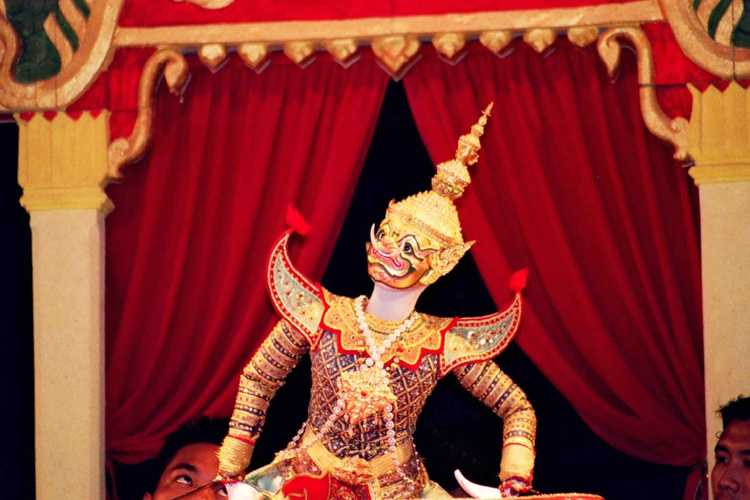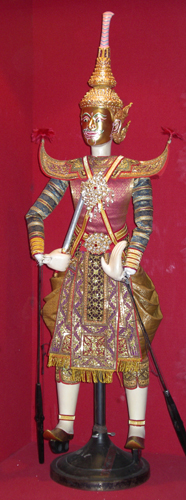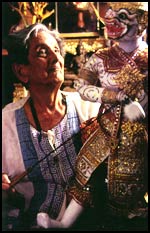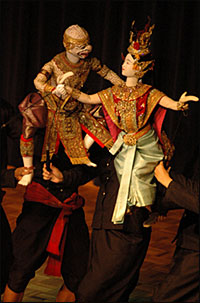

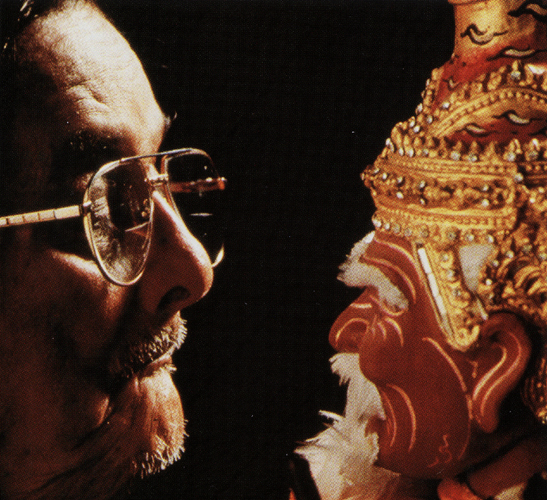
Joe Louis
Among Maestro Krae Saptawanit 's troupe of puppeteers was a married couple, Kui and Chuam Yangkhieosot. They were leading puppeteers, and Kui, the husband, took charge of the mascot - the supernumerary character ' Jek Heng', a comic and lovable Chinaman who does not feature in original version of any Thai drama but whose role was to add humor through irrelevant and silly remarks and generally to engage the audience. One afternoon in 1922, while the troupe travelled by boat to give a performance at Temple of Pak Klong Takrai in Nontaburi province (immediately north Bangkok), Chuam gave birth to a baby boy. Krae 's wife, Plung, named the child Sut Sakorn after one of the character in the puppet play to be performed that afternoon. Sut Sakorn was sickly child. and it was believed that his name was inauspicious. To save that child , Kui and Chuam shortened the child 's name to Sakorn, and presented him to a monk at the temple of jangwan Dit with the request that the monk save him.The monk re - named the child ' Lhiew' which means 'willow'. The boy soon recovered from his various illnesses and grew up to become a precociously talented khon dancer, and lakorn and likay performer. He went on tour with different khon, lakorn and likay troupes. In the likay theater, he played the part of jester. He was, However, not taught the art of puppetry until he was older because puppets are not toys and could be representations of mythological deities. Lhiew was , in fact, forbidden to touch the puppets. But children are children, and Lhiew no exception: he would sneak into the room where the puppets were kept to manipulated and play with them, and sometimes he was caught and punished. Needless to say, when he grew old enough to be taught the art of puppetry, he became an instant master of it and a star puppeteer in Maestro Krae Saptawanit 's troupe
e Second World War and the Post-war Years The tranquil existence of this unsual performing at was interrupted by the World War (1939- 45), but its nadir was not reached until the post-war years when first motion pictures, then television, were introduced to Thailand. Theatrical puppetry, along with other traditional forms of staged entertainment, came to be regarded as old fashioned. Its popularity waned, and the general public eventually forgot that his art form ever existed. Maestro Krae grew old and eventually gave some thirty of his puppets to his son , Thong Yhoo , and to his daughter-in-law, Yhib. In despair and fearing that others might steal the rest from him, he threw them into the river. Later , when Yhib herself grew old , she gave the puppets to Lhiew - the youngest member of defunct Maestro Krae 's troupe - in the hope that he would repair them. The puppets were, however, beyond repair, and as there was no public demand to see them, let alone to see performances, they all went into storage. His hope of praticing and preserving that art was destroyed by social changes and economic realities. Living in premature artist retirement and oblivion, he made a meager living by manufacturing khon masks, but there was little demand for them ,too. Several decades later, the remaining puppets were given to Muang Boran ( Ancient City Park), where they can still be seen today.
One day, when Lhiew was old , and nearly 40 years after he gave his last performance, he nostalgically made his first puppet. He made it exactly the way he used to make them when he was young. It was a puppet of and old hermit from the Ramakian.His children were fascinated. They had see the original puppets when they were young . before the puppets were given to Muang Boran . Now, they - all nine of them - were keen to learn to make them and to manipulate them. They were keen to learn from their father, the last living person in the world who knew and had learnt from the founder of this arcane art. And so it was in his home that the art of theatrical puppetry was revived and perserved.
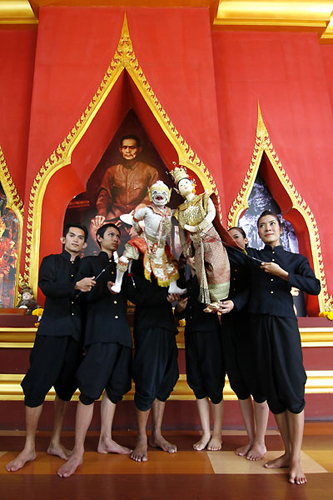
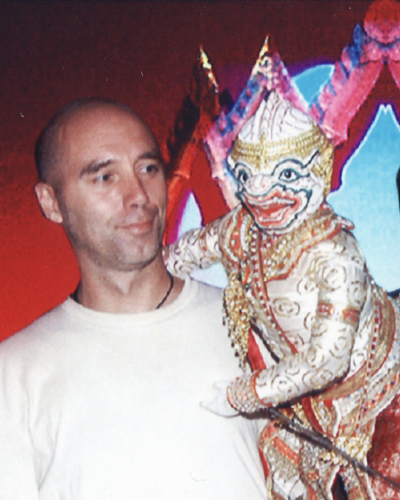
The theatrical puppetry is unique among the various forms of puppetry in that each puppet represents a character taken from the traditional Thai theater. There are three types of traditional Thai theatrical performances, all of which are stylized, with dancing, singing and music comparable in complexity with the European opera-ballet of the 18th century French royal court at Versailles. The most sophisticated of these is named "khon", which performs only the ramakian (the Thai version of the Indian epic, Ramayana); the less sophisticated, named "lakhorn", performs all other classics of Thai drama; and the least sophisticated is "likay", which performs common dramas.Thai theatrical puppetry is also unique in that each puppet requires the synchronised efforts of three puppeteers for its manipulation, all of whom appear on stage with the puppet and each of whom is a khon, lakhon or likay performer in his or her own right. The puppets, in short, perform khon, lakhon or likay on stage with the puppeteers, hence the name 'theatrical puppetry'. The Traditional Thai Puppet Theater Company is the authoritative guardian of this dying art form: the directors and senior members of the troupe are direct artistic successors of the founder of Thai theatrical puppetry. Performances are as unique as they are authentic.
Performance at the Traditional Thai Puppet Theater are a showcase for Thailand 's cultural heritage and reflect the untiring efforts of the troupe to preserve and perpetuate this exotic art form.
Creation
Thai theatrical puppetry was created in 1901 by the legendary khon dancer, Krae Saptawanit. Maestro Krae was inspired to create puppets when he saw the grace and ingenuity of the royal puppets and of the puppets of the deputy king 's palace. The first puppet he created was a male character of the khon stage . This puppet stood two feet tall. However, he found that in order to make its movements realistic and approximate the movements of khon dances, he needed the help of his theatrical colleagues. The mechanisms and the techniques were quickly perfected, and a new kind of puppetry was invented.
Early Popularity
After creating his first puppet and perfecting the mechanism and the techniques for manipulating it, Maestro Krae Saptawanit made more puppets and soon founded a troupe of puppeteers that could perform khon with puppets. Performances were frequent and popular. Each principal character was manipulated by three puppeteers, while the others were manipulated by two puppeteers, or even by one puppeteer, depending on how much movement was required. In the early decades of the theatrical puppetry, the puppeteers stood behind a screen and manipulated the puppets above it, so the viewers could only see the puppets but not the puppeteers. There were male and female puppeteers, but there was no strict division of labor.
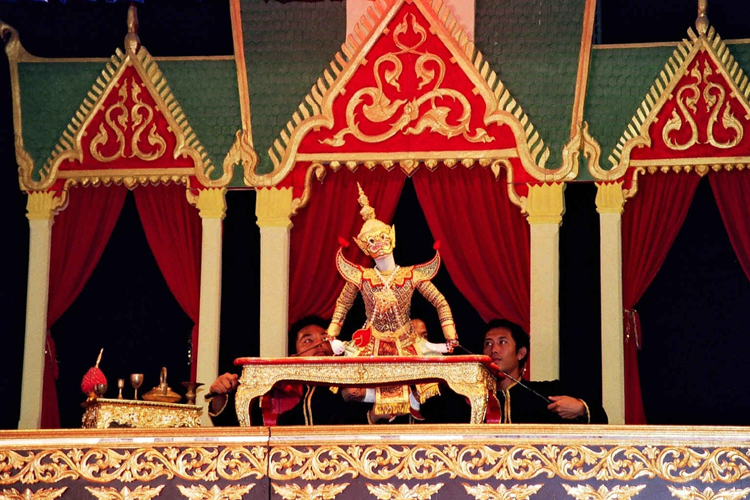
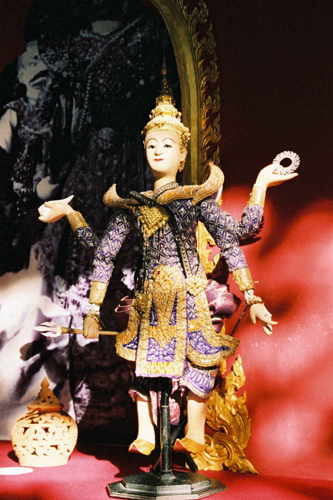
Sahorn as "National Artist"
In 1996, His Majesty the King recognized Sakorn as the custodian of this arcane and dying art form, and bestowed upon him the honorific title of National Artist. This made it possible for theatrical puppetry to be revived and, in turn, for the Traditional Thai Puppet Theater to be founded.
The Name "Joe Louis"
Lhiew 's name was eventually mispronounced as 'Lui' , and when the Amerrica boxer, Joe Louis, become World Champion (1937 - 1949), Lhiew was nicknamed 'Joe Louis' by his friends and by those is the performing arts. His real name, however, was Sakorn.
Death of Grand Master Puppeteer Sakorn Yangkhieosot
Grand Master Puppeteer Sakorn Yangkhieosot passed away on 21 may 2007 having accomplished his life 's ambition : the preservation and revival of the exotic Thai art of 'Small Theatrical Puppetry', His work is now faithfully continued by his devoted and extraordinarily talented sons and daughters who run The Traditional Thai Puppet Theatre.
The Name
Thai aristocrats and theater people who saw Maestro Krae Saptawanit 's performances called his invention "Hun Lakorn Lek" -'hun' means model or puppet; 'lakorn' refers to staged drama; and 'lek' means small because the puppets were smaller than the characters of Thai staged dramas. The original Thai name is sometimes translated as 'Small Theatrical Puppetry', which is misleading in European languages as western puppets are always small, and to add the adjective ' small' to puppets would suggest that the puppets are minuscule. In fact, the so- called 'Small Theatrical Puppets' first created by Maestro Krae Saptawanit have grown: they now are three feet high. Therefore, the word 'small' has been appropriately dropped from the English name.
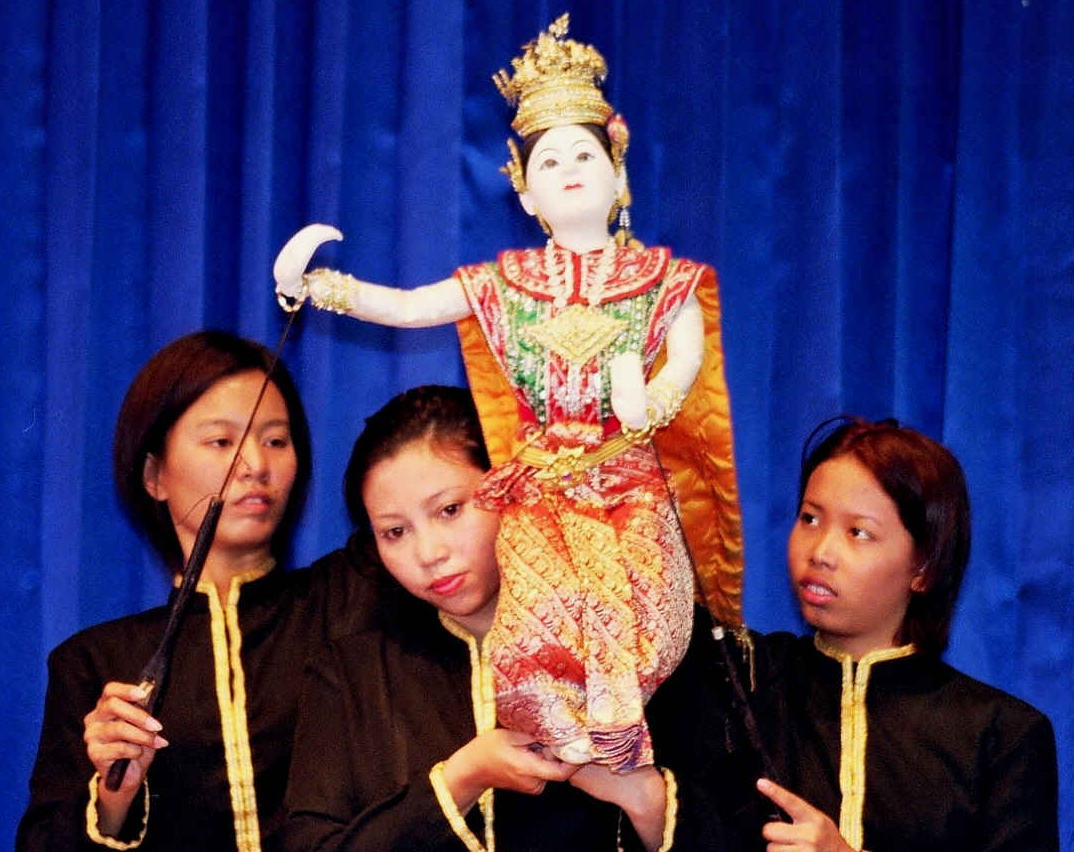
In 1984, Sakorn set up a booth at the annual Suan Am porn Fair in Bangkok to demonstate the ancient art of making knon Masks. He took with him to the booth the puppet the old hermit from the Ramakian he had made. The pupput attracted attention, and when the Tourism Authority of thailand discovered that this impoverished old man was the last living person who knows the art of theatrical puppetry, it offered him money to make more puppets and revive performances. The following year, Sakorn and his children gave a performance at the fair. He named the troupe 'Hun Lakorn Lek, Sakorn Natasilp Troupe: Maestro Krae's Grandchildren's Lakorn Lek'. The revival was welcomed but there was not enough demand for performances for it to be sustainable or viable as a liveihood.
In 1996, the Commission for Nation Culture nominated Sakron for the title of 'National Artist (Performing Arts Category: Small Theatrical Pupperty)'. This nomination was made in the name of His Majesty the King, in whose name the honorific title of ' National Artist' was bestowed. The accompanying medal was awarded by Her Royal Highness Princess Sirinthorn, daugther of His Majesty. This recognition enabled Sakron and his children to raise enough money to open a small puppet theatre near their home in Nontaburi province. The theater was consecrated on 28th December 1999, and the first performance was given on 3rd January 2000. The theater was called the 'Joe Louis Theater'. The revival wasstill not successful: the theater was rudimentary and too remote from the metropoils, and few went to see it. In May 2002, the theater was moved to its present and more central location at the Suan Lum Night Bazaar in Bangkok.
On 10th July 2002, Her Royal Highness Princess Sirinthorn, His Majesty's daughter, officially opened the theatre and unveiled the plaque. On 5th December 2004, Her Royal Highness Princess Galyani Vadhana, sister of his Majesty the King, re-named the theater ' Nattayasala Hun Lakorn Lek' in Thai and the Traditional Thai Puppet Theater' in English. The Traditional Thai Puppet Theater Foundation is under Her Royal Highness's patronage.
